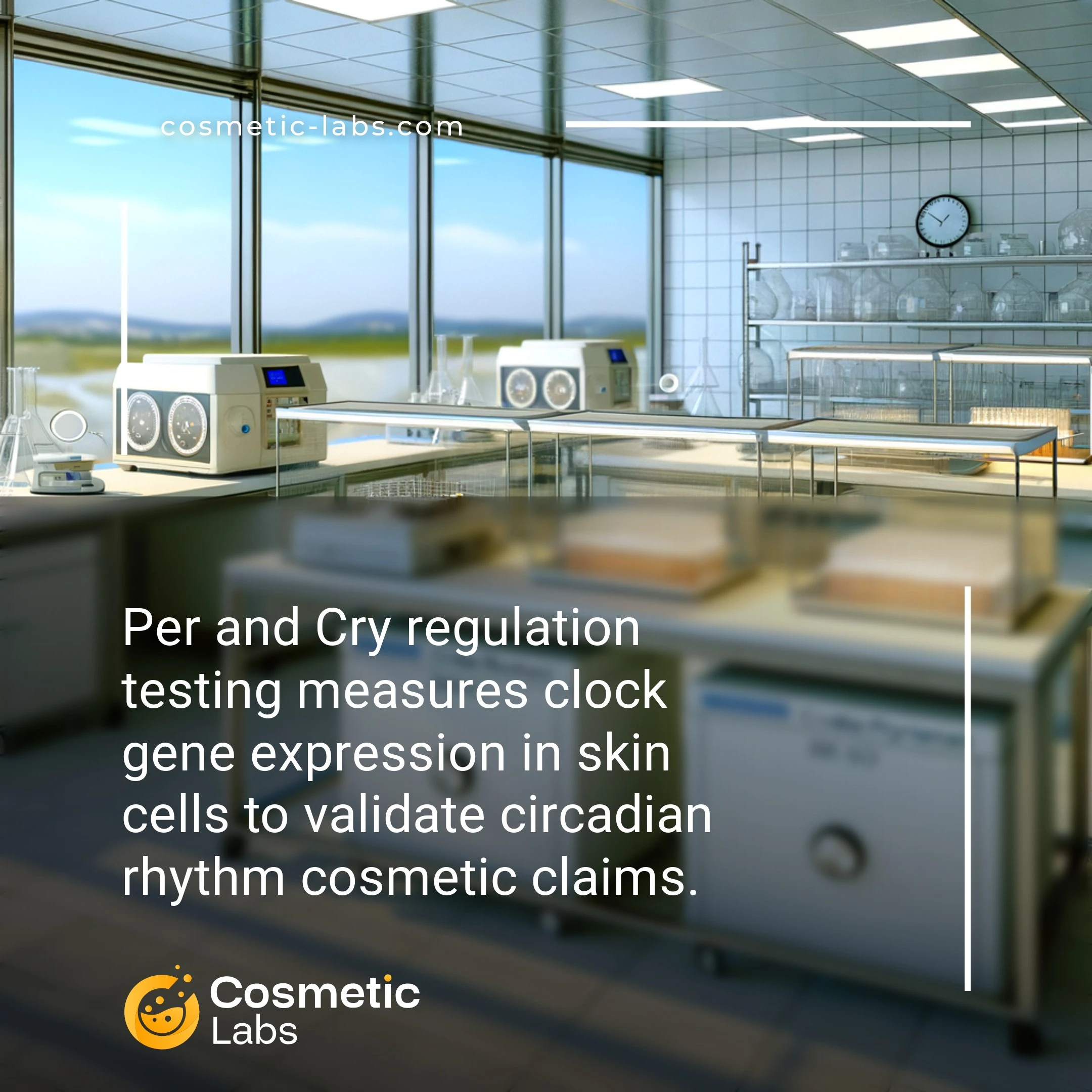Per Cry Gene Testing for Circadian Beauty Product Claims

What is Per and Cry regulation?
Per and Cry gene regulation testing for circadian rhythm efficacy measures how cosmetic ingredients influence the body’s natural 24-hour clock by tracking Period (Per) and Cryptochrome (Cry) gene expression patterns. Our partner labs use real-time PCR analysis and chronobiology protocols to validate claims about sleep-promoting serums, anti-aging night creams, and morning energizing formulations. This testing reveals whether your product actually synchronizes with skin’s natural repair cycles, providing scientific proof for circadian-based marketing claims that resonate with today’s wellness-focused consumers.
Why do you need this service?
Beauty brands use Per and Cry gene expression analysis to validate anti-aging serums and sleep-promoting skincare formulations before market launch. Labs measure how active ingredients influence cellular clock mechanisms in skin tissue samples, providing quantifiable proof of circadian synchronization benefits that support marketing claims and regulatory submissions for night repair creams and chronobiology-based cosmetic products.
Who provides Per and Cry regulation services?
All cosmetic labs providing Per and Cry regulation services
There is no company providing these services at the moment.
Period and Cryptochrome Gene Expression Analysis for Circadian Rhythm Testing
Cosmetic labs now measure Period and Cryptochrome gene regulation to validate how skincare ingredients affect your skin’s natural 24-hour cycle. This molecular testing approach examines the core clock genes that control cellular repair, barrier function, and collagen synthesis throughout the day.
Molecular Clock Gene Expression Profiling
Labs use RT-PCR and gene sequencing to track Per1, Per2, Cry1, and Cry2 expression levels in skin cell cultures. These circadian clock genes oscillate every 24 hours, controlling when cells repair DNA, produce antioxidants, and synthesize structural proteins. Testing typically runs for 48-72 hours to capture multiple circadian cycles.
Key measurements include:
- Peak expression timing for each gene
- Amplitude changes after ingredient exposure
- Phase shift analysis compared to control samples
- Synchronization patterns between different clock genes
Functional Circadian Rhythm Validation
Beyond gene expression, labs test how Period and Cryptochrome regulation translates into actual skin functions. They measure collagen production rates, antioxidant enzyme activity, and barrier repair capacity at different times of day. This functional testing proves whether your ingredient actually improves skin’s natural rhythms.
Testing protocols examine:
- Time-dependent collagen synthesis rates
- Antioxidant enzyme cycling patterns
- DNA repair efficiency across 24-hour periods
- Barrier function recovery timing
Connect with specialized labs on our platform to validate your circadian skincare formulations through precise molecular clock analysis.
Applications of Per and Cry Gene Regulation Testing for Circadian Rhythm Efficacy
Beauty brands use Per and Cry gene regulation testing to validate claims about circadian rhythm support in skincare formulations and demonstrate measurable biological activity.
Anti-Aging Product Development
Labs measure Per1, Per2, and Cry1 gene expression changes in human skin cells exposed to active ingredients. Testing protocols track circadian clock gene activity over 24-48 hour cycles using qPCR analysis. Brands developing night creams with melatonin, retinol, or peptides rely on this data to support “works with your skin’s natural rhythm” claims.
Results show percentage increases in clock gene expression, with effective formulations demonstrating 15-40% upregulation of Per genes during specific circadian phases. This data strengthens product positioning and regulatory submissions.
| Gene Target | Testing Timeline | Typical Response Range | Application Focus |
|---|---|---|---|
| Per1/Per2 | 24-48 hours | 15-40% upregulation | Anti-aging, repair |
| Cry1/Cry2 | 48-72 hours | 20-35% modulation | Sleep beauty, recovery |
| Clock/Bmal1 | 72 hours | 10-25% enhancement | Rhythm restoration |
Sleep Beauty and Recovery Formulations
Cosmetic labs test overnight treatment products by analyzing how ingredients influence Cry gene expression patterns. Testing involves exposing cultured skin cells to formulations containing adaptogens, CBD, or chronobiotic compounds. Labs track gene expression shifts that indicate improved cellular repair timing and stress response regulation.
Brands launching “sleep masks” or “recovery serums” use this testing to validate timing-specific benefits. Data shows optimal application windows and ingredient concentrations that maximize circadian gene activation during natural repair phases.
Ready to validate your circadian rhythm claims with Per and Cry gene testing? Connect with specialized cosmetic labs on our platform to discuss your specific formulation needs and testing protocols.
